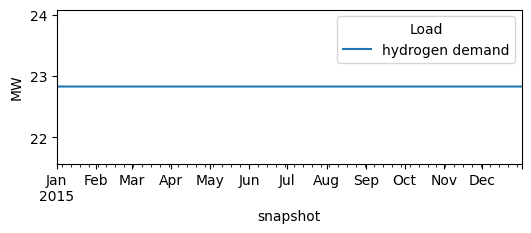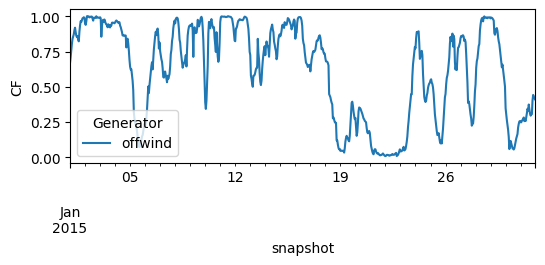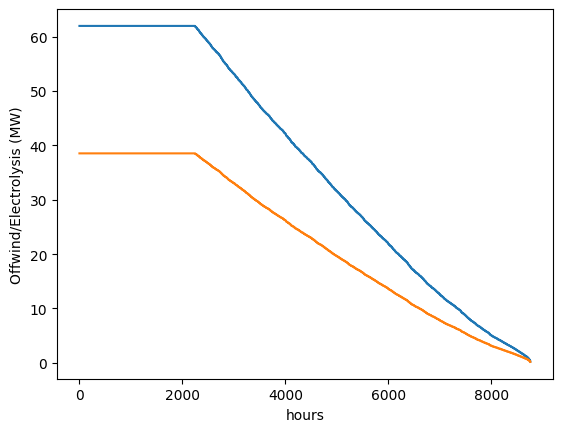Problem 12.1#
Integrated Energy Grids
Problem 12.1. Hydrogen production in an energy island.
In this problem, we want to build a stylized mode of hydrogen production in an energy island. Assume an offshore generator and an electrolyzer with the cost in Table. For the offshore generator, assume the capacity factors for Denmark.
An annual hydrogen demand of 200 GWh must be delivered and, for the sake of simplicity, assume that the island includes a hydrogen storage with no cost. The electrolyzer efficiency is assumed to be 62%.
Note
If you have not yet set up Python on your computer, you can execute this tutorial in your browser via Google Colab. Click on the rocket in the top right corner and launch “Colab”. If that doesn’t work download the .ipynb file and import it in Google Colab.
Then install pandas and numpy by executing the following command in a Jupyter cell at the top of the notebook.
!pip install pandas pypsa
import matplotlib.pyplot as plt
import pandas as pd
import numpy as np
import pypsa
Prerequisites: handling technology data and costs#
We maintain a database (PyPSA/technology-data) which collects assumptions and projections for energy system technologies (such as costs, efficiencies, lifetimes, etc.) for given years, which we can load into a pandas.DataFrame. This requires some pre-processing to load (e.g. converting units, setting defaults, re-arranging dimensions):
year = 2030
url = f"https://raw.githubusercontent.com/PyPSA/technology-data/master/outputs/costs_{year}.csv"
costs = pd.read_csv(url, index_col=[0, 1])
costs.loc[costs.unit.str.contains("/kW"), "value"] *= 1e3
costs.unit = costs.unit.str.replace("/kW", "/MW")
defaults = {
"FOM": 0,
"VOM": 0,
"efficiency": 1,
"fuel": 0,
"investment": 0,
"lifetime": 25,
"CO2 intensity": 0,
"discount rate": 0.07,
}
costs = costs.value.unstack().fillna(defaults)
costs.at["OCGT", "fuel"] = costs.at["gas", "fuel"]
costs.at["OCGT", "CO2 intensity"] = costs.at["gas", "CO2 intensity"]
Let’s also write a small utility function that calculates the annuity to annualise investment costs. The formula is
where \(r\) is the discount rate and \(n\) is the lifetime.
def annuity(r, n):
return r / (1.0 - 1.0 / (1.0 + r) ** n)
annuity(0.07, 20)
0.09439292574325567
Based on this, we can calculate the marginal generation costs (€/MWh):
costs["marginal_cost"] = costs["VOM"] + costs["fuel"] / costs["efficiency"]
and the annualised investment costs (capital_cost in PyPSA terms, €/MW/a):
annuity = costs.apply(lambda x: annuity(x["discount rate"], x["lifetime"]), axis=1)
costs["capital_cost"] = (annuity + costs["FOM"] / 100) * costs["investment"]
We can now read the capital and marginal cost of onffhore wind and electrolysis
costs.at["offwind", "capital_cost"] #EUR/MW/a
np.float64(174556.22307975945)
costs.at["electrolysis", "capital_cost"] #EUR/MW/a
np.float64(188715.7758309984)
Retrieving time series data#
In this example, wind data from https://zenodo.org/record/3253876#.XSiVOEdS8l0 and solar PV data from https://zenodo.org/record/2613651#.X0kbhDVS-uV is used. The data is downloaded in csv format and saved in the ‘data’ folder. The Pandas package is used as a convenient way of managing the datasets.
For convenience, the column including date information is converted into Datetime and set as index
data_offwind = pd.read_csv('data/offshore_wind_1979-2017.csv',sep=';')
data_offwind.index = pd.DatetimeIndex(data_offwind['utc_time'])
The data format can now be analyzed using the .head() function to show the first lines of the data set
data_offwind.head()
| utc_time | BEL | DEU | DNK | GBR | NLD | SWE | FIN | FRA | IRL | NOR | |
|---|---|---|---|---|---|---|---|---|---|---|---|
| utc_time | |||||||||||
| 1979-01-01 00:00:00+00:00 | 1979-01-01T00:00:00Z | 0.513 | 0.875 | 0.986 | 0.522 | 0.484 | 0.712 | 0.470 | 0.296 | 0.676 | 0.232 |
| 1979-01-01 01:00:00+00:00 | 1979-01-01T01:00:00Z | 0.367 | 0.861 | 0.985 | 0.549 | 0.322 | 0.713 | 0.384 | 0.331 | 0.584 | 0.180 |
| 1979-01-01 02:00:00+00:00 | 1979-01-01T02:00:00Z | 0.372 | 0.845 | 0.978 | 0.551 | 0.267 | 0.711 | 0.321 | 0.343 | 0.466 | 0.161 |
| 1979-01-01 03:00:00+00:00 | 1979-01-01T03:00:00Z | 0.351 | 0.819 | 0.968 | 0.498 | 0.274 | 0.709 | 0.271 | 0.223 | 0.389 | 0.163 |
| 1979-01-01 04:00:00+00:00 | 1979-01-01T04:00:00Z | 0.338 | 0.787 | 0.957 | 0.457 | 0.274 | 0.708 | 0.224 | 0.189 | 0.270 | 0.168 |
We will use timeseries for Denmark in this excercise
country = 'DNK'
Join capacity and dispatch optimization#
For building the model, we start again by initialising an empty network, adding the snapshots, the electricity and the hydrogen bus.
n = pypsa.Network()
hours_in_2015 = pd.date_range('2015-01-01 00:00Z',
'2015-12-31 23:00Z',
freq='h')
n.set_snapshots(hours_in_2015.values)
n.add("Bus", "electricity")
n.add("Bus", "hydrogen")
n.snapshots
DatetimeIndex(['2015-01-01 00:00:00', '2015-01-01 01:00:00',
'2015-01-01 02:00:00', '2015-01-01 03:00:00',
'2015-01-01 04:00:00', '2015-01-01 05:00:00',
'2015-01-01 06:00:00', '2015-01-01 07:00:00',
'2015-01-01 08:00:00', '2015-01-01 09:00:00',
...
'2015-12-31 14:00:00', '2015-12-31 15:00:00',
'2015-12-31 16:00:00', '2015-12-31 17:00:00',
'2015-12-31 18:00:00', '2015-12-31 19:00:00',
'2015-12-31 20:00:00', '2015-12-31 21:00:00',
'2015-12-31 22:00:00', '2015-12-31 23:00:00'],
dtype='datetime64[ns]', name='snapshot', length=8760, freq=None)
Next, we add the hydrogen demand time series to the model. We add a “free” H2 store in the hydrogen bus.
annual_hydrogen_demand = 200000 #MWh
hydrogen_demand = annual_hydrogen_demand/8760*np.ones(8760)
n.add("Load",
"hydrogen demand",
bus = "hydrogen",
p_set=hydrogen_demand)
n.add("Store",
"hydrogen store",
bus = "hydrogen",
e_nom_extendable=True,
e_cyclic=True) # cyclic state of charge
Index(['hydrogen store'], dtype='object')
Let’s have a check whether the data was read-in correctly.
n.loads_t.p_set.plot(figsize=(6, 2), ylabel="MW")
<Axes: xlabel='snapshot', ylabel='MW'>

We add now the offshore wind generator and set up the capacity to be extendable so that it can be optimized. We need to indicate the capacity factor or maximum power per unit ‘p_max_pu’
CF_wind = data_offwind[country][[hour.strftime("%Y-%m-%dT%H:%M:%SZ") for hour in n.snapshots]]
n.add(
"Generator",
"offwind",
bus="electricity",
p_max_pu=CF_wind.values,
capital_cost=costs.at["offwind", "capital_cost"],
marginal_cost=costs.at["offwind", "marginal_cost"],
p_nom_extendable=True,
)
Index(['offwind'], dtype='object')
So let’s make sure the capacity factors are read-in correctly.
n.generators_t.p_max_pu.loc["2015-01"].plot(figsize=(6, 2), ylabel="CF")
<Axes: xlabel='snapshot', ylabel='CF'>

We add the electrolyzer.
n.add(
"Link",
"electrolysis",
bus0="electricity",
bus1="hydrogen",
p_nom_extendable=True,
efficiency=costs.at["electrolysis", "efficiency"],
capital_cost=costs.at["electrolysis", "capital_cost"] #EUR/MW/a,
)
Index(['electrolysis'], dtype='object')
Model Run#
We can already solve the model using the open-solver “highs” or the commercial solver “gurobi” with the academic license
n.optimize(solver_name="highs")
WARNING:pypsa.consistency:The following links have carriers which are not defined:
Index(['electrolysis'], dtype='object', name='Link')
WARNING:pypsa.consistency:The following buses have carriers which are not defined:
Index(['electricity', 'hydrogen'], dtype='object', name='Bus')
WARNING:pypsa.consistency:The following stores have carriers which are not defined:
Index(['hydrogen store'], dtype='object', name='Store')
INFO:linopy.model: Solve problem using Highs solver
INFO:linopy.io:Writing objective.
Writing constraints.: 0%| | 0/14 [00:00<?, ?it/s]
Writing constraints.: 64%|██████▍ | 9/14 [00:00<00:00, 83.30it/s]
Writing constraints.: 100%|██████████| 14/14 [00:00<00:00, 40.75it/s]
Writing continuous variables.: 0%| | 0/7 [00:00<?, ?it/s]
Writing continuous variables.: 100%|██████████| 7/7 [00:00<00:00, 107.29it/s]
INFO:linopy.io: Writing time: 0.43s
Running HiGHS 1.10.0 (git hash: fd86653): Copyright (c) 2025 HiGHS under MIT licence terms
LP linopy-problem-7i0j9jx5 has 78843 rows; 35043 cols; 140163 nonzeros
Coefficient ranges:
Matrix [3e-03, 1e+00]
Cost [2e-02, 2e+05]
Bound [0e+00, 0e+00]
RHS [2e+01, 2e+01]
Presolving model
26280 rows, 17522 cols, 61320 nonzeros 0s
Dependent equations search running on 8760 equations with time limit of 1000.00s
Dependent equations search removed 0 rows and 0 nonzeros in 0.00s (limit = 1000.00s)
26280 rows, 17522 cols, 61320 nonzeros 0s
Presolve : Reductions: rows 26280(-52563); columns 17522(-17521); elements 61320(-78843)
Solving the presolved LP
Using EKK dual simplex solver - serial
Iteration Objective Infeasibilities num(sum)
0 0.0000000000e+00 Pr: 8760(408858) 0s
12870 6.6613408488e+03 Pr: 4651(3.06916e+08) 5s
19185 1.6754589201e+07 Pr: 6022(2.09079e+07) 10s
23187 2.7120307929e+07 Pr: 47(1525.9) 15s
23228 2.7120673406e+07 Pr: 0(0) 16s
Solving the original LP from the solution after postsolve
Model name : linopy-problem-7i0j9jx5
Model status : Optimal
Simplex iterations: 23228
Objective value : 2.7120673406e+07
Relative P-D gap : 1.2018982576e-13
HiGHS run time : 15.62
Writing the solution to /tmp/linopy-solve-by2j9dhi.sol
INFO:linopy.constants: Optimization successful:
Status: ok
Termination condition: optimal
Solution: 35043 primals, 78843 duals
Objective: 2.71e+07
Solver model: available
Solver message: Optimal
INFO:pypsa.optimization.optimize:The shadow-prices of the constraints Generator-ext-p-lower, Generator-ext-p-upper, Link-ext-p-lower, Link-ext-p-upper, Store-ext-e-lower, Store-ext-e-upper, Store-energy_balance were not assigned to the network.
('ok', 'optimal')
Now, we can look at the results and evaluate the total system cost (in billion Euros per year)
n.objective / 1e9
0.02712067340607038
a) What is the optimum capacity of offshore wind and electrolyzer that needs to be installed?
The optimised capacities in GW, notice that we are representing some technologies using generator components and other using link components, so we need to check both.
n.generators.p_nom_opt
Generator
offwind 88.30876
Name: p_nom_opt, dtype: float64
n.links.p_nom_opt
Link
electrolysis 61.992749
Name: p_nom_opt, dtype: float64
b) What is the optimal storage capacity of hydrogen, in absolute terms and relative to the annual demand?
n.stores.e_nom_opt
Store
hydrogen store 19955.611164
Name: e_nom_opt, dtype: float64
The optimal energy capacity of the hydrogen storage represents 5% of the annual hydrogen demand
n.stores.e_nom_opt['hydrogen store']/n.loads_t.p_set['hydrogen demand'].sum()
np.float64(0.09977805582191851)
c) Plot the duration curve for offshore wind generation and electrolyzer operation and discuss the results. Compare the capacity factor corresponding to wind power availability and the utilization factor for the electrolyzer.
Even though electrolysis capacity is expensive, it is sized to obtain an utilization factor of 0.59.
duration_offwind=n.generators_t.p["offwind"].sort_values(ascending=False)
duration_electrolysis=-n.links_t.p1["electrolysis"].sort_values(ascending=True)
plt.plot(duration_offwind.values)
plt.plot(duration_electrolysis.values)
plt.ylabel("Offwind/Electrolysis (MW)")
plt.xlabel("hours")
Text(0.5, 0, 'hours')

(duration_electrolysis/duration_electrolysis.max()).mean()
np.float64(0.5923850967229963)
The Capacity Factor (CF) for offshore wind can be calculated as
n.generators_t.p_max_pu["offwind"].mean()
np.float64(0.4562141552511415)
At what cost can the H\(_2\) be produced and how does it compare to current H\(_2\) price?
We can calculate the cost ob producing H\(_2\) by using the total system cost or averaging the marginal price of the hydrogen bus.
n.objective / n.loads_t.p_set['hydrogen demand'].sum()
np.float64(135.60336703035188)
n.buses_t.marginal_price['hydrogen'].mean()
np.float64(135.60336703041995)
Assuming 33 kWh/kg of Hydrogen, 146 EUR/MWh corresponds to 4.8 EUR/kg while the current price for hydrogen produced via steam methane reforming is around 1.5 EUR/kg (while emitting CO2)
146/1000*33
4.818

